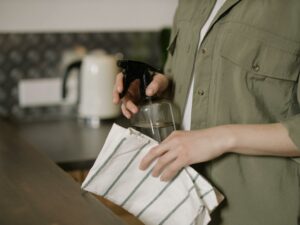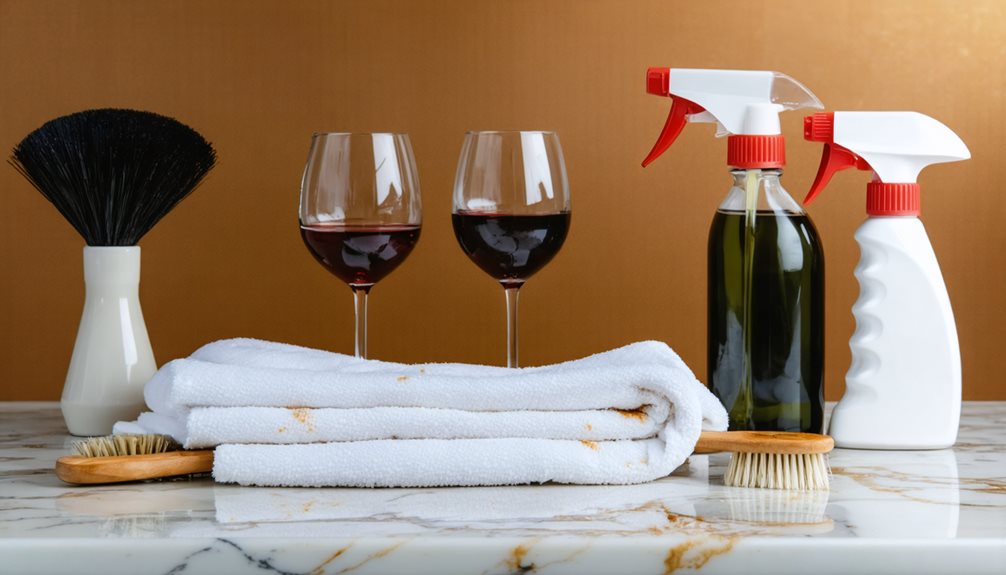Effective stain removal requires prompt action and proper identification of the stain type. Water-based stains respond well to cold water treatment, while oil-based stains need initial absorption with materials like baking soda. Protein-based stains demand enzymatic cleaners, and tannin stains often require specialized solutions. Natural cleaners offer eco-friendly alternatives, though chemical products may be necessary for stubborn marks. Professional techniques emphasize blotting rather than rubbing to prevent deeper embedding. Success rates diminish significantly after 24 hours, making swift response essential. Understanding these fundamental principles forms the foundation for mastering advanced stain removal strategies.
Key Takeaways
- Immediate blotting with clean cloths and cold water treatment within the first hour significantly increases successful stain removal chances.
- Different stains require specific treatments: water-based need cold water, oil-based need absorbents, and protein-based need enzymatic cleaners.
- Professional cleaning services offer advanced equipment and expertise for deep-set stains that resist conventional cleaning methods.
- Natural solutions like vinegar and baking soda provide cost-effective alternatives for many stains while minimizing environmental impact.
- Strategic combination of both natural and chemical cleaners yields optimal results for tough household stains.
Understanding Different Types of Stains
In the domain of stain removal, understanding the distinct characteristics of different stain types is essential for effective treatment. Stains can be classified into five primary categories, each demanding specific cleaning solutions and methodologies for successful elimination.
Water-based stains, commonly originating from beverages like coffee or fruit juices, respond well to prompt treatment with cold water applications. In contrast, oil-based stains present unique challenges due to their hydrophobic properties, requiring absorbent materials such as baking soda for initial treatment. Protein-based types of stains, including blood and perspiration, demand immediate intervention with cold water and enzymatic cleaning solutions to prevent setting.
Tannin stains, derived from wine and tea, constitute another distinct category that often requires specialized treatments, including vinegar or commercial stain removers. The fifth category, dye stains, typically necessitates specific removal techniques based on the particular dye compound involved. Understanding these fundamental classifications enables the selection of appropriate cleaning methods, maximizing the likelihood of successful stain removal while minimizing potential damage to the affected materials.
Quick Response Stain Treatment Methods
Immediate action following a stain incident represents the vital difference between successful removal and permanent fabric damage. An effective first-aid stain response begins with blotting the affected area using clean, absorbent materials and applying appropriate solutions based on the stain type – cold water for protein-based stains and vinegar solutions for water-based stains. Maintaining a well-equipped emergency stain removal kit, complete with specialized cleaning agents, white cloths, and precise application tools, enables swift intervention during those vital initial moments when stain removal success rates are highest.
First-Aid Stain Response
Quick intervention when facing a stain can mean the difference between successful removal and permanent damage to your fabric. The initial response should always be to blot the stain with a clean cloth, avoiding rubbing motions that could spread the contaminant deeper into the fibers. This vital first step helps absorb excess liquid and prevents the stain from setting.
Understanding the nature of the stain determines the appropriate treatment method. For water-based stains, apply a solution of vinegar and water to remove the mark effectively. Oil-based stains require a two-step approach: first, apply baking soda to absorb excess grease, then treat with dish soap. When confronting protein-based stains, immediately use cold water, followed by hydrogen peroxide if necessary.
Before applying any cleaning products, perform a spot test on an inconspicuous area to verify fabric compatibility. This precautionary step prevents potential damage or discoloration. By following these methodical first-aid responses and using appropriate cleaning techniques based on stain type, you significantly increase the likelihood of successful stain removal while maintaining fabric integrity.
Emergency Stain Removal Kit
A well-stocked emergency stain removal kit serves as an essential defense against unexpected spills and marks on fabrics. The fundamental components should include absorbent paper towels, clean blotting cloths, dish soap, white vinegar, baking soda, and specialized enzyme-based cleaners. These items enable rapid response to various types of stains before they become permanent.
Critical to the kit’s effectiveness is the inclusion of a spray bottle for creating diluted cleaning solutions, particularly useful for water-based stains. When addressing unexpected marks, the ability to quickly blot excess liquid is paramount, making absorbent materials readily accessible. A portable stain remover pen complements the kit, offering immediate treatment options when away from home.
Proper maintenance of your emergency stain removal kit requires regular inventory checks and replacement of depleted or expired items. Effective cleaning techniques emphasize swift action and proper methodology: always blot rather than rub, work from the stain’s outer edge inward, and select appropriate cleaning agents based on the stain type. This systematic approach, combined with well-maintained supplies, maximizes the chances of successful stain removal.
Immediate Action Saves Fabrics
Responding swiftly to fabric stains dramatically increases the probability of successful removal, particularly within the first hour after the incident occurs. Research demonstrates that stain removal success rates decline significantly after 24 hours, making immediate action essential for best results.
When addressing fresh stains, proper technique is fundamental. Start by blotting the affected area with a clean, white cloth to absorb excess liquid, avoiding rubbing motions that can embed the stain deeper into fabric fibers. For protein-based stains, such as blood or perspiration, rinse with cold water immediately to prevent protein molecules from bonding with the textile material.
Temperature selection plays a significant role in stain treatment effectiveness. Cold water is the preferred initial treatment for most stains, as hot water can permanently set certain types of stains, particularly those containing proteins or dyes. Following the initial response, apply appropriate stain-specific treatments promptly. This methodical approach, combining immediate action with proper stain removal techniques, maximizes the likelihood of complete stain elimination and helps preserve fabric integrity. Professional-grade results are most achievable when addressing stains without delay.
Common Household Stain Solutions
Effective stain removal begins with understanding the specific characteristics of common household stains and their appropriate treatment methods. Different types of stains require specific approaches, and using the wrong treatment can permanently set a stain rather than remove it. For best results, act quickly and choose the appropriate cleaning solution based on the stain’s composition.
When dealing with common household stains, follow these essential guidelines:
- For beverage stains like coffee and wine, immediately blot the area with a clean cloth and cold water, avoiding hot water which can set the stain. Apply a gentle stain remover or white vinegar solution.
- Address protein-based stains with enzymatic cleaners, which effectively break down organic materials. These cleaners are particularly effective on blood, sweat, and food stains.
- For ink and dye-based stains, use rubbing alcohol or specialized cleaning solutions, applying multiple treatments if necessary. When DIY methods prove insufficient, consult a professional cleaning service.
Remember that stubborn stains may require multiple treatments, and delicate fabrics often benefit from professional expertise to prevent damage during the cleaning process.
Natural Vs Chemical Cleaning Products
When evaluating cleaning products for stain removal, consumers must weigh the environmental impact and safety considerations of natural solutions against chemical alternatives. Natural cleaners, including vinegar and baking soda, offer eco-friendly and non-toxic options with minimal environmental footprint, though they may require additional effort or multiple applications to achieve desired results. Chemical cleaners typically demonstrate superior efficacy on tough stains and provide broader cleaning capabilities, but their potentially harmful ingredients and higher production costs warrant careful consideration of the cost-effectiveness ratio and safety protocols during use.
Environmental Impact Assessment
Through extensive environmental analysis, the contrast between natural and chemical cleaning products reveals significant ecological implications. Natural cleaning products, formulated with biodegradable ingredients, demonstrate markedly reduced environmental pollution compared to their chemical counterparts. This distinction becomes particularly evident when examining the long-term effects on aquatic ecosystems and air quality.
Scientific assessments have identified three critical environmental advantages of natural cleaning solutions:
- Reduced VOC emissions, resulting in improved indoor air quality and decreased respiratory health risks
- Minimal toxic residue accumulation on household surfaces, preventing harmful chemical build-up as documented by EPA studies
- Lower carbon footprint throughout the product lifecycle, from manufacturing to disposal
The environmental impact extends beyond immediate use, affecting resource consumption and waste management. While chemical cleaners rely heavily on non-renewable resources and generate hazardous waste during production, natural alternatives utilize sustainable materials and support circular economy principles through compostable end-products. This comprehensive assessment demonstrates that natural cleaning products offer a more environmentally responsible solution while maintaining effective cleaning capabilities.

Ingredient Safety Comparison
Safety analysis of cleaning product ingredients stands at the forefront of consumer health considerations, building upon the established environmental implications. When conducting an ingredient safety comparison between natural cleaning products and chemical cleaners, several critical factors emerge. Natural products typically contain familiar substances like vinegar, baking soda, and citrus-based ingredients, which pose minimal risk to household occupants and pets. These components rarely trigger adverse reactions and maintain good air quality within living spaces.
Chemical cleaners, while rigorously regulated with mandatory safety labeling, often incorporate synthetic compounds that may cause respiratory irritation or skin sensitivity in some individuals. The stringent labeling requirements for these products reflect their potentially hazardous nature and necessary handling precautions. Research indicates that natural cleaning products generally provide a safer alternative for daily household maintenance, particularly in homes with children, pets, or individuals with sensitivities. However, it’s important to note that even natural ingredients can cause reactions in sensitive individuals, though such cases are significantly less common than with chemical alternatives. The selection of cleaning products should therefore prioritize both efficacy and safety considerations specific to household circumstances.
Cost vs. Effectiveness
The comparative analysis of natural versus chemical cleaning products reveals significant cost and performance trade-offs that influence consumer choices. Natural solutions like vinegar and baking soda demonstrate superior cost-effectiveness, often costing mere cents per application compared to several dollars for commercial alternatives. However, their effectiveness varies depending on the cleaning challenge at hand.
When evaluating cleaning options, consider these key factors:
- Chemical cleaners deliver faster results on tough stains like grease and mildew, but come with higher costs and potential health and safety concerns
- Natural solutions offer multi-purpose applications, reducing the need for multiple specialized products while maintaining a safer environment for families and pets
- The long-term cost savings of natural cleaners compound when factoring in their versatility and reduced environmental impact
While natural cleaners excel in routine cleaning tasks and food-based stains, chemical products may be necessary for specific challenging situations. The best approach often involves strategically combining both methods—utilizing natural cleaners for daily tasks where their effectiveness is proven, while reserving chemical solutions for stubborn stains that require more aggressive treatment.
Deep-Set Stain Removal Techniques
When confronting deep-set stains that have become embedded in fabrics or surfaces, specialized treatment methods become essential for effective removal. Professional cleaners understand that different types of stains require specific approaches, with enzymatic cleaners being particularly effective for protein-based stains such as blood and sweat.
Deep cleaning techniques often involve steam treatment, which proves highly effective in loosening stubborn stain particles from carpet and upholstery fibers. The combination of heat and moisture penetrates deep into the material, facilitating more thorough stain removal. For challenging dye-based stains, such as ink or paint, a methodical approach using rubbing alcohol and precise blotting techniques is necessary to extract the pigments without compromising fabric integrity.
In cases where conventional methods prove insufficient, industrial-grade equipment and specialized solutions available through professional cleaning services become necessary. These advanced tools, combined with expert knowledge, can address severely embedded stains that resist standard cleaning methods. Multiple treatments may be required, with appropriate intervals between applications to prevent material damage while maximizing stain removal effectiveness.
Professional Cleaning Service Guidelines
Professional cleaning services follow three essential guidelines to guarantee ideal stain removal results: proper assessment of materials, selection of appropriate cleaning agents, and implementation of targeted treatment protocols. These established procedures guarantee superior outcomes when dealing with stubborn stains while protecting the integrity of the treated surfaces.
Professional cleaning services employ specialized techniques and products that significantly outperform standard household cleaning methods. Their systematic approach includes:
- Material Analysis – Thorough examination of fabric composition, surface type, and stain characteristics to determine the most effective treatment strategy
- Advanced Equipment Deployment – Utilization of industrial-grade machinery and enzymatic cleaners specifically designed for challenging stains
- Customized Treatment Plans – Implementation of tailored cleaning protocols based on surface requirements and stain composition
The expertise of professional cleaners extends beyond basic stain removal, encompassing comprehensive surface maintenance and protection. Their knowledge of cutting-edge cleaning technologies and access to professional-grade products enables them to address complex staining issues effectively. Regular professional cleaning services not only eliminate existing stains but also help prevent future damage through proper maintenance and protection protocols, ultimately extending the lifespan of treated materials.
Frequently Asked Questions
What Is the Best Solution for Tough Stains?
Professional cleaning services offer the most effective solution for tough stains through their comprehensive approach. Their specialized equipment, including industrial-grade steam cleaners and advanced enzymatic solutions, effectively breaks down and removes stubborn stains. The combination of expert knowledge, professional-grade equipment, and targeted cleaning agents guarantees peak results. Additionally, their methodical treatment processes protect fabric integrity while addressing various stain types, from protein-based to synthetic dyes.
What Is the Common Technique for Stain Removal?
Picture a race against time where every second counts – this perfectly describes the most common and effective technique for stain removal. The key is immediate action, coupled with gentle blotting rather than aggressive rubbing. Using a clean white cloth, apply pressure to absorb the stain, working from the outer edges toward the center. This methodical approach prevents spreading and deeper penetration of the substance into fabric fibers.
How Do You Fix a Bad Stain Job?
To fix a bad stain job, first evaluate the stain type and fabric composition. Apply an appropriate specialized stain remover, focusing on breaking down the residual compounds. Gently blot the area with cold water, avoiding rubbing which can spread the stain. For persistent stains, soak the garment overnight in a solution of water and suitable stain treatment. If unsuccessful, seek professional cleaning services, particularly for delicate or valuable items.
What Is the Best Stain Remover for Old Stubborn Stains?
In terms of fighting old stains, there’s no one-size-fits-all solution. The key is matching the right remover to the specific stain type. Enzymatic cleaners are your best bet for protein-based stains, while oxygen bleach works wonders on colorfast fabrics. For grease, a dish soap and baking soda paste is highly effective. Stubborn dye stains respond well to rubbing alcohol. For particularly challenging cases, professional cleaning services offer specialized treatments.





